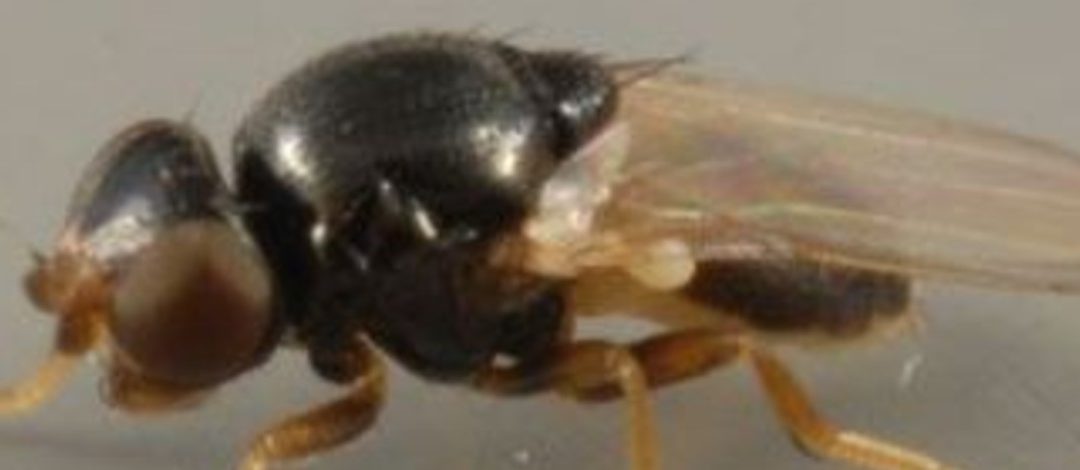
by Larry Williams | Jun 26, 2025
If you’ve been outside this spring, you’ve probably been bothered by gnats. These tiny flies relentlessly congregate near the face getting into the eyes, nose, mouth and ears.
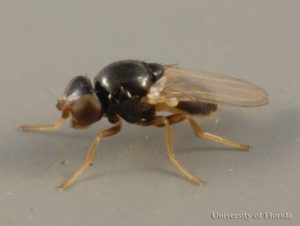
Eye gnat. Credit: Lyle Buss, UF/IFAS
Eye gnats come right up to the faces of people and animals because they feed on fluids secreted by the eyes, nose and ears. Even though eye gnats are considered mostly a nuisance, they have been connected to transmission of diseases such as pink eye.
Eye gnats are true flies. At about one-sixteenth of an inch in length, they are among the smallest fly species in Florida. They are known as eye gnats, eye flies, frit flies and grass flies. The name grass flies is somewhat descriptive as open grass areas such as pastures, hay fields, roadsides and lawns provide breeding sites for these gnats. They also breed in areas of freshly disturbed soil with adequate organic matter such as livestock farms.
Even though these gnats can be found in much of North and South America, they prefer areas with warm, wet weather and sandy soils. Sounds like Florida.
An early spring and plenty of rain are the more likely reasons why these gnats are such a problem in our area this year. Without having the typical last killing frost around mid-March and with early warm weather and rains, the gnats got off to an early start.
Short of constantly swatting them away from your face or just not going outdoors, what can be done about these irritating little flies? I grew up in an area of Georgia where gnats are common. I’ll let you in on a secret, folks who live in Georgia are known to be overly friendly because they are always waving at people who are just passing through. More than likely, these “friendly” folks are busy swatting at gnats, not waving at others who happen to be driving by. Swatting is a quick swinging action with hand as if waving.
Because of their lifecycle, extremely high reproductive numbers in the soil and because insecticides breakdown quickly, area-wide chemical control efforts don’t work well in combating this insect.
The use of the following where gnats are common can be helpful.
- Correct use of insect repellents, particularly those containing DEET
- Screens on windows to prevent the entry of gnats into homes
- Face-hugging sunglasses or other protective eyewear
- Face masks
We may have to put up with these annoying gnats until cold weather arrives and be thankful that they don’t bite.
Additional info on eye gnats is available online at https://edis.ifas.ufl.edu/in884 or from the UF/IFAS Extension Office in your County.
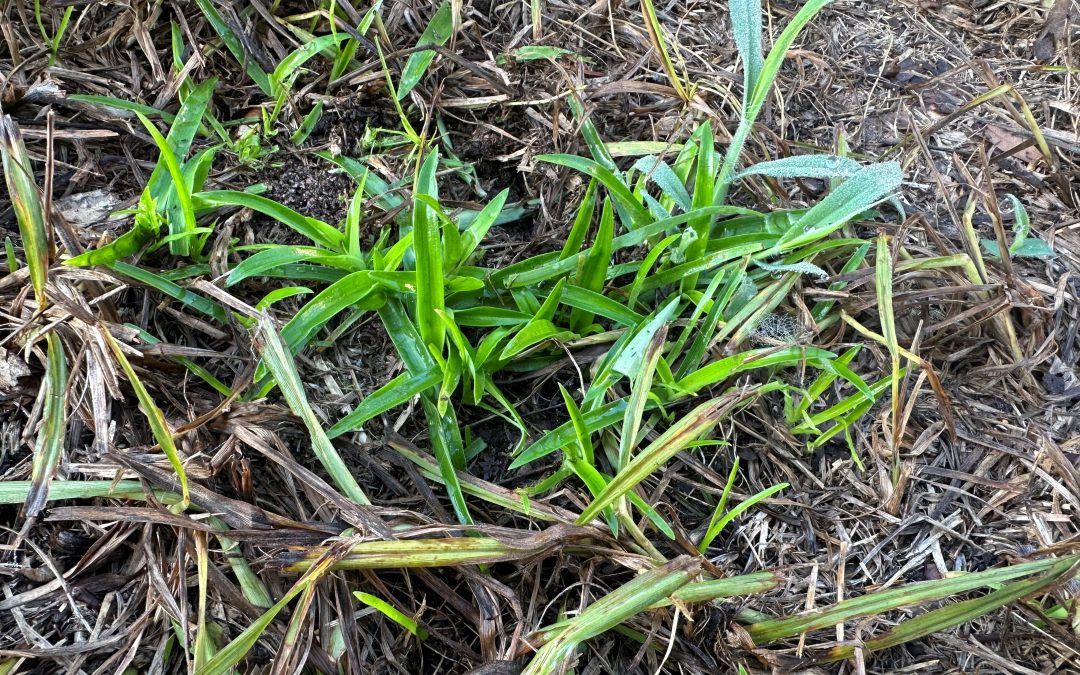
by Daniel J. Leonard | Jun 5, 2025
The Panhandle’s dreaded summer heat has finally arrived in force and has brought with it one of the most difficult to control lawn/landscape weeds, our annual enemy Doveweed (Murdannia nudiflora). Doveweed is characterized as one of the world’s worst weeds due to its broad range of growing conditions, ability to root along its stems, forming mats as it grows, massive seed production (each plant can produce up to 2,000 seeds per year), and inconspicuous nature – it looks like a grass to the untrained eye. So, what can gardeners do to control Doveweed that’s already up this year and prevent it next summer? Let’s find out.
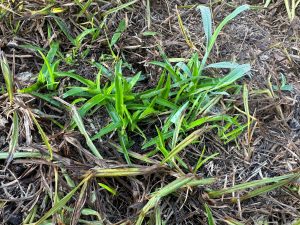
Doveweed emerging in a bare patch of a Centipedegrass lawn in late May 2025. Photo courtesy of Daniel Leonard.
First, the best prevention for all weeds, Doveweed included, is a healthy lawn/landscape. Ensuring healthy, thick Centipedegrass turf and landscaped beds that don’t allow light to hit bare soil goes a long way towards reducing the overall weed load lawns and landscapes can experience. For lawns, this can be achieved through mowing regularly at the proper height for your turfgrass (2.5” or so for Centipedegrass), irrigating no more than 0.75”-1” per week in the absence of rain, limiting stress from overfertilization, and removing excess thatch. In landscapes, preventative weed control focuses on limiting overwatering/fertilization and maintaining a 2-3” organic mulch layer of pinestraw, pine bark, leaves, wood chips, etc. Adopting these practices can greatly reduce the occurrence of weeds in your yard, however they will not eliminate weeds altogether and supplemental chemical weed control is often necessary.
Unlike Crabgrass, Florida Pusley, and other commonly encountered Panhandle annual weeds that emerge when the soil begins to warm in early spring (usually late February-March), Doveweed waits until mid-April-May (soil temperatures of 70-80 degrees F). All these annual weeds are best controlled by preemergent herbicides, like Indaziflam (Specticle G), before seeds germinate. For Doveweed, that means the first preemergent application should occur mid-April with a follow-up application 6-8 weeks later. However, for this year that opportunity is behind us and our only option is post emergent herbicides.
Which postemergent herbicide you choose depends on if your Doveweed issue is in turfgrass or in landscaped beds. In landscaped beds, the primary control option is either hand pulling or spot treating Doveweed with a 41% glyphosate product (Roundup and other generic products) at a rate of 3% (3-4oz glyphosate/gal). As glyphosate is a non-selective herbicide, be sure to not get any overspray on any ornamental plant foliage. In turfgrass, Doveweed control becomes a little more difficult. You essentially have three options – atrazine, a generic 3-way broadleaf product, or a commercial grade broadleaf product. Though it provides very good control of Doveweed and has pre-emergent properties to help discourage future weeds, I don’t prefer atrazine because it has a high potential to leach into groundwater following heavy rains in sandy soils, which describes much of the Panhandle. The generic 3-way products (usually a mix of Dicamba, Mecoprop, and 2,4-D) are fairly effective on Doveweed, however follow-up applications are usually required and the 2-4D component can be harsh on Centipedegrass at the higher label rates required for Doveweed control. Though somewhat expensive, the best post emergent option for most people is probably a commercial grade product like Celsius WG. Celsius WG is a very strong post emergent broadleaf herbicide that is very effective on Doveweed and is also very safe on Centipedegrass, even in hot weather. If the cost of the product (>$100) is off-putting, it is helpful to remember that even at the highest labelled rate, a 10 oz Celsius WG bottle goes a long way, enough to cover several acres of lawn.
* Regardless of what method you choose, be sure to get after emerged Doveweed seedlings early, before they mature and begin flowering – even the strongest post emergent herbicides work better on young weeds.
While Doveweed is a nasty little plant that is perfectly capable of taking over a lawn or landscaped bed, there are a variety of preventative and control options available. Using a combination of the above techniques should help achieve lasting Doveweed controls in future seasons! For more information about Doveweed and other summer annual weed control in lawns and landscapes, contact your local UF/IFAS Extension County office.
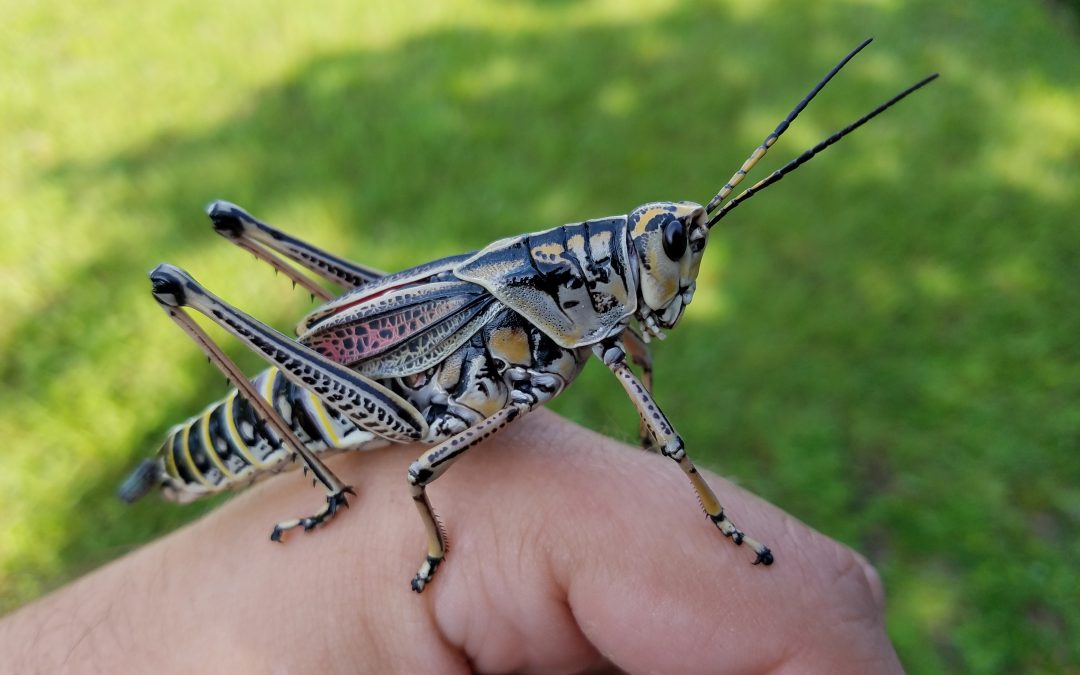
by Evan Anderson | Jun 5, 2025
The Eastern Lubber Grasshopper
From spring to early summer every year, a certain grasshopper can be seen in the Florida panhandle: the eastern lubber, also known as the Georgia thumper. Sometimes emerging in huge numbers, this can be distressing to residents who suddenly find themselves amidst what might appear to be a plague of biblical proportions. Females lay eggs in the soil, and seem to prefer woodland areas with soil that is neither too wet or too dry. With each female laying one or more ‘pods’ of eggs, and each pod containing up to 80 eggs, this can lead to a lot of grasshoppers!
Nymphs are the young and immature form of the grasshopper, and appear different than the adults. Newly hatched lubbers are black with a yellow, orange, or red stripe running down their backs. They range from about ½ inch to 1 ¾ inch long while still in the nymphal stage, and tend to stay together in groups. Adults are seen most often starting in July, growing to a size of up to 3 ½ inches in length. Adults may remain black, but are often seen in lighter colors, from yellow to orange.
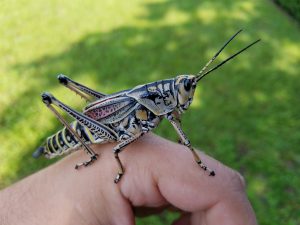
An adult eastern lubber grasshopper.
Eastern lubbers feed on a wide variety of plants. While adults prefer low, wet areas, they will sometimes damage crops or ornamental plants. They eat less than one might expect, given their size, but groups can still defoliate plants if left unchecked. Thankfully, they cannot fly, and therefore do not range over a wide area individually.
If these grasshoppers become a problem in landscapes or gardens, control methods are best undertaken early, while the insects are young. If populations are not great, they can be hand picked and removed. If treatment with insecticide is desired, there are several products available that kill lubbers. For individuals desiring a more ‘natural’ insecticide, products with the active ingredient spinosad are relatively safe to use, if slow acting. Spinosad should be applied in the early morning, late evening, or at night, to avoid affecting foraging pollinators such as bees.
Other insecticides will also work, including those with the active ingredients carbaryl, bifenthrin, cyhalothrin, permethrin, or esfenvalerate. Note that the active ingredient may not be the same as the brand name, and may only be listed in smaller print in the ‘ingredients’ portion of the product’s label. Avoid applying insecticides too close to water bodies, as they may harm fish.
For more information, see the EDIS publication on eastern lubbers at https://edis.ifas.ufl.edu/publication/IN132.
Evan Anderson
Walton County Horticulture Agent
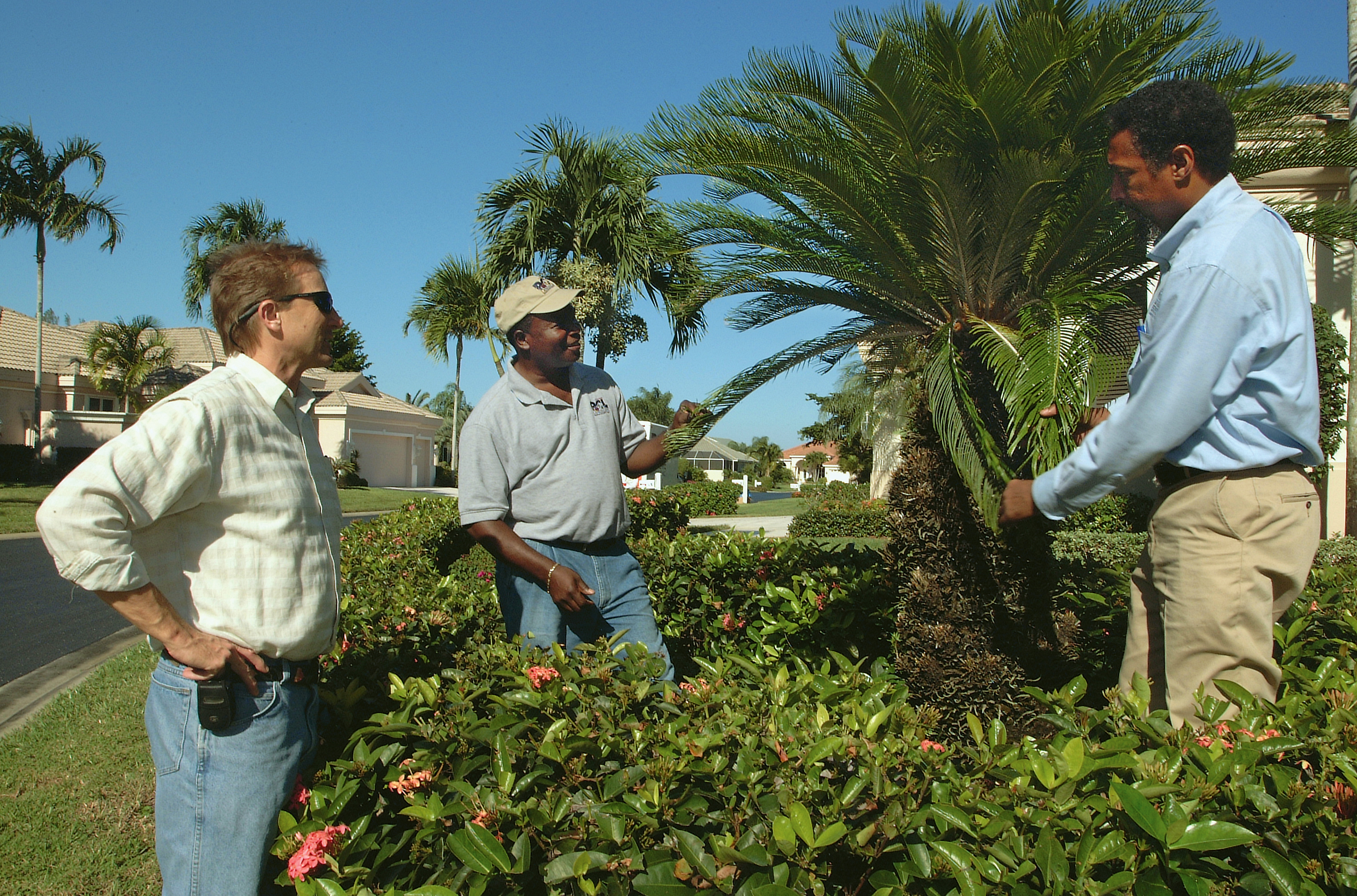
by Matt Lollar | May 28, 2025
Gardening just wouldn’t be any fun without the pests. In this episode of Gardening in the Panhandle LIVE!, the hosts answered some very important questions about different types of pests in Florida lawns and landscapes. Before we talk about some of the specific topics from this episode, it’s critical to know the definition of a pest when it pertains to our yards. A pest is any organism that is harmful and/or damaging to humans or the property of humans such as crops and livestock. Weeds are pests, some insects are pests, and diseases are pests.
Integrated Pest Management or IPM for short is the use of different pest management strategies to help control pests. The UF/IFAS Publication Landscape Integrated Pest Management provides more details on the steps involved in a good IPM program.
As stated above, pests can come in a lot of forms. Pesticides offer control for some pests. The article The Basics of Pesticides provides more information on using pesticides.
“Natural” can be a vague term. You’ll want to read the UF/IFAS publication Natural Products for Managing Landscape and Garden Pests in Florida to help clarify the definition of natural pesticides and offer some natural control options.
If you’re growing edible crops, then you’ll need to follow some extra precautions to make sure your crops are safe to eat. A Florida-Friendly Landscaping Approach to Pest Management in Your Edible Landscape provides IPM strategies specific to fruits, vegetables, and herbs utilized in the landscape.
Some annual weeds are easier to control as the germinate. Pre-emergent herbicides provide a barrier that kills most annual weeds shortly after they germinate. Apply pre-emergent herbicides in late winter before day temperatures reach 65°F–70°F for 4 or 5 consecutive days and in the fall when nighttime temperatures drop to 55°F–60°F for several consecutive days.
The first step of IPM is to scout for pests. More information on scouting can be found in the article Scouting: The tip of the IPM spear from Matt Smith with the UF/IFAS Extension in Lake County.
The larva of many beetle species like to eat turfgrass roots. More information on June beetles and their control can be found in the fact sheet June Beetles (White Grubs).
Ground pearls are very difficult to control. The UF/IFAS publication Ground Pearls, Margarodes spp. (Insecta: Hemiptera: Margarodidae offers detailed information of these underground relatives of armored scales.
Snakes usually help us control pests around our homes. If you’re interested in what snake species live in Florida, then you’ll want to read the UF/IFAS publication Managing Conflicts with Wildlife: Living with Snakes.
Chinch bugs are a major insect pest of Saint Augustinegrass. The UF/IFAS publication Southern Chinch Bug, Blissus insularis Barber (Insecta: Hemiptera: Blissidae) provides some valuable information on this insect pest and how to control it.
Fire ants are a direct pest of humans and the create some unsightly mounds in the yard. A number of baits are available on the market to help keep them out of the landscape. The article Sustainable Fire Ant Control offers more details on baits and other fire ant control strategies.
Mole crickets are another type of insect that feed on turfgrass roots. The Mole Cricket IPM Guide for Florida is a great place to start if you’re trying to understand this pest better.
If you’re sticking with an edible landscape theme, then you’ve certainly encountered leaf-footed bugs and stinkbugs on your fruit and vegetable crops. Larry Williams with the UF/IFAS Extension in Okaloosa County has written a very informative article on leaf-footed bugs titled Leaf-footed Bugs Are Common On Tomatoes.
The extension publication Weed Management Guide for Florida Lawns offers a variety of weed management strategies for your yard.
Weed control in plant beds can sometimes be tricky. The UF/IFAS publication Improving Weed Control in Landscape Planting Beds provides solutions for managing weeds around shrubs and ornamentals.
Products containing glyphosate are good for spot spray applications in the landscape, however some people may choose to avoid its use. The UF/IFAS publication Use of Glyphosate and Herbicide Alternatives for Weed Control in Florida Landscape Planting Beds discusses the advantages and disadvantages of using glyphosate and other herbicides.
Pests can wreak havoc on healthy lawns and landscapes. The resources and advice provided in this episode of Gardening in the Panhandle LIVE! will help you maintain a beautiful setting to enjoy. To view this episode of Gardening in the Panhandle LIVE! please visit our YouTube channel.
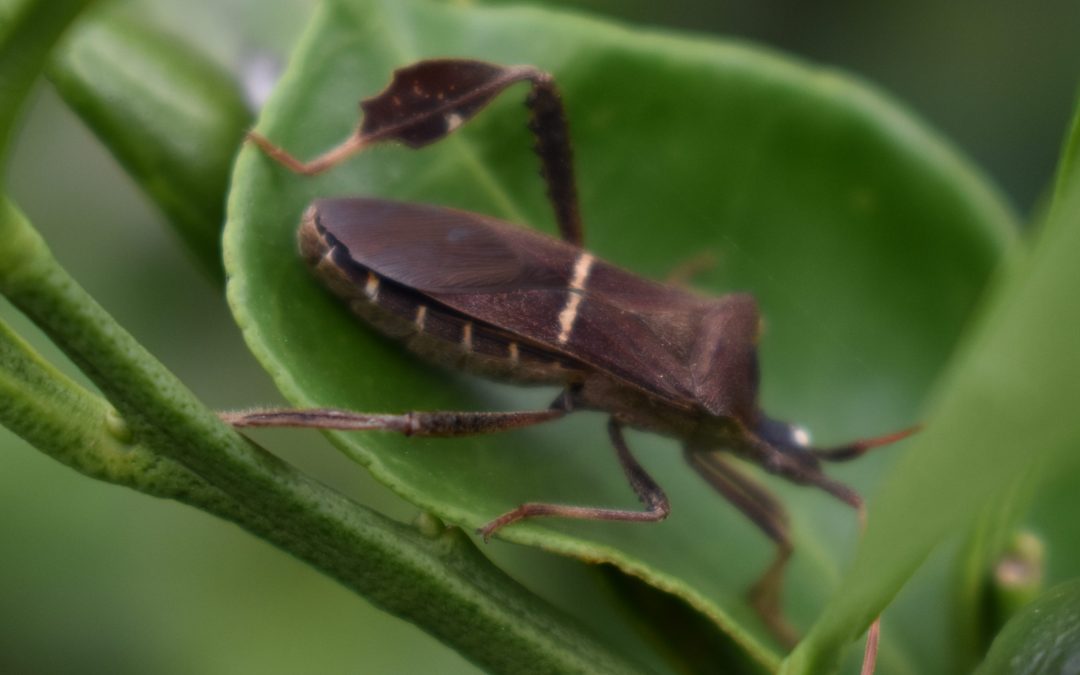
by Donna Arnold | Sep 30, 2024
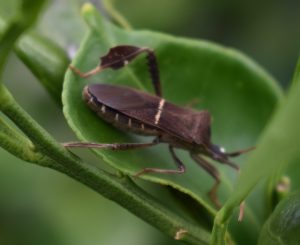
Photo Credit: Danielle S. Williams
Florida is home to at least nine species of insects from the genus Leptoglossus, some of which possess “foliaceous hind tibiae,” but only Leptoglossus phyllopus has earned the common name “leaf-footed bug.” This insect, a close relative of the stink bug, plays a fascinating yet problematic role in gardens. The nymphs are bright orange, while the adults are brown with a distinct flattened, leaf-shaped structure on their hind legs. Unfortunately, both stages of the leaf-footed bug are notorious pests, causing significant damage to buds, flowers, fruits, and seeds.
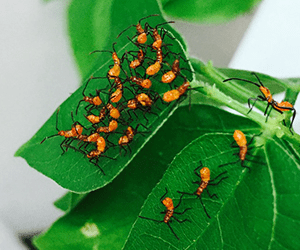
Photo Credit: Jennifer Carr
These pests feed on a wide variety of plants, including tomatoes, peaches, blueberries, beans, okra, and sunflowers. Their feeding activity can cause yellow and brown spots, misshapen fruits, and shriveled produce, depending on the severity and timing of the infestation.
In the fall, leaf-footed bugs can gather on warm windowsills or home siding. They can sometimes find openings in homes and get inside, but they don’t cause any damage indoors and don’t deposit eggs. Adult leaf-footed bugs also seek shelter in weedy areas or beneath layers of mulch and debris. They lay their eggs in neat rows on the undersides of leaves or along stems, with eggs hatching within 5 to 7 days. The nymphs then mature in approximately 25 to 30 days, leading to a rapid increase in population.
Integrated Pest Management (IPM) strategies are highly effective for controlling leaf-footed bugs. IPM involves a combination of cultural, physical/mechanical, biological, and—when necessary—chemical control methods. Following the IPM triangle approach, gardeners can start with the least harmful methods (like cultural practices) and gradually escalate to chemical controls if needed, depending on the infestation threshold. Early scouting and intervention are crucial to preventing the population from escalating throughout the growing season.
Though there are only a few organic pesticides that effectively manage leaf-footed bugs, proactive steps like hand-picking and reducing overwintering sites can help curb their numbers in the following year. For larger infestations, homeowners might consider using pyrethroids, which should be applied according to the manufacturer’s instructions. Leaf-footed bugs are also susceptible to insecticidal soaps and other pyrethroid-based products available at most garden retailers.
A word of caution: Some beneficial insects, such as assassin bugs, resemble the orange nymphs of leaf-footed bugs. Be sure to correctly identify these insects to avoid harming species that are beneficial to your garden.
For more information about leaf-footed bugs and effective control measures click on the link below or contact your local Extension office for more details.
https://edis.ifas.ufl.edu/publication/in229
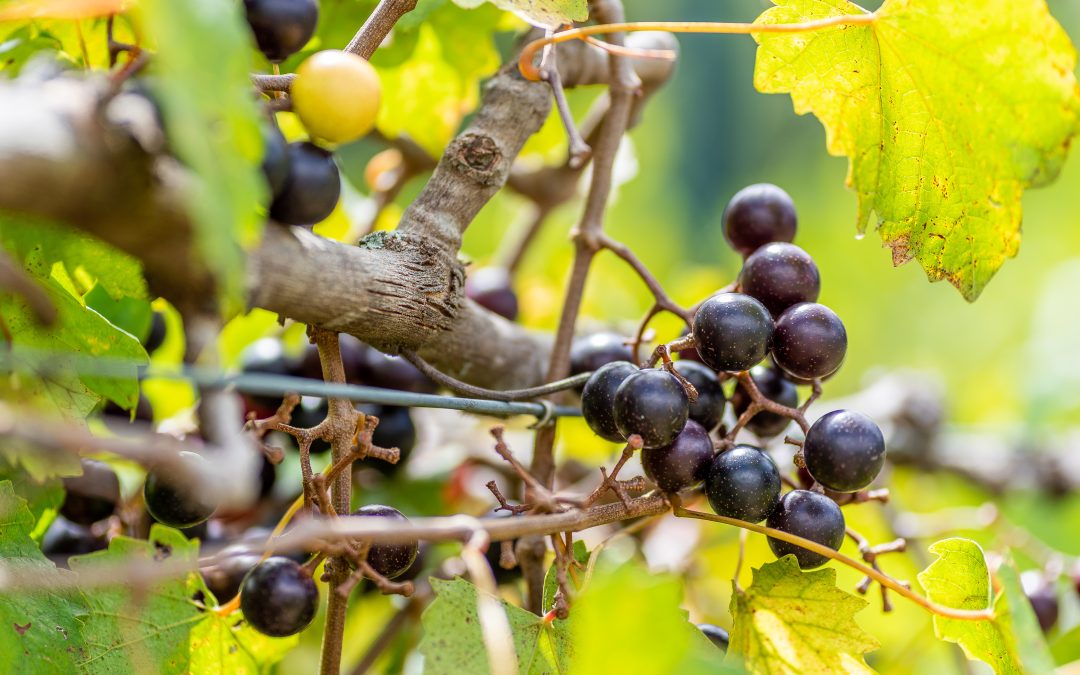
by Molly Jameson | Aug 7, 2024
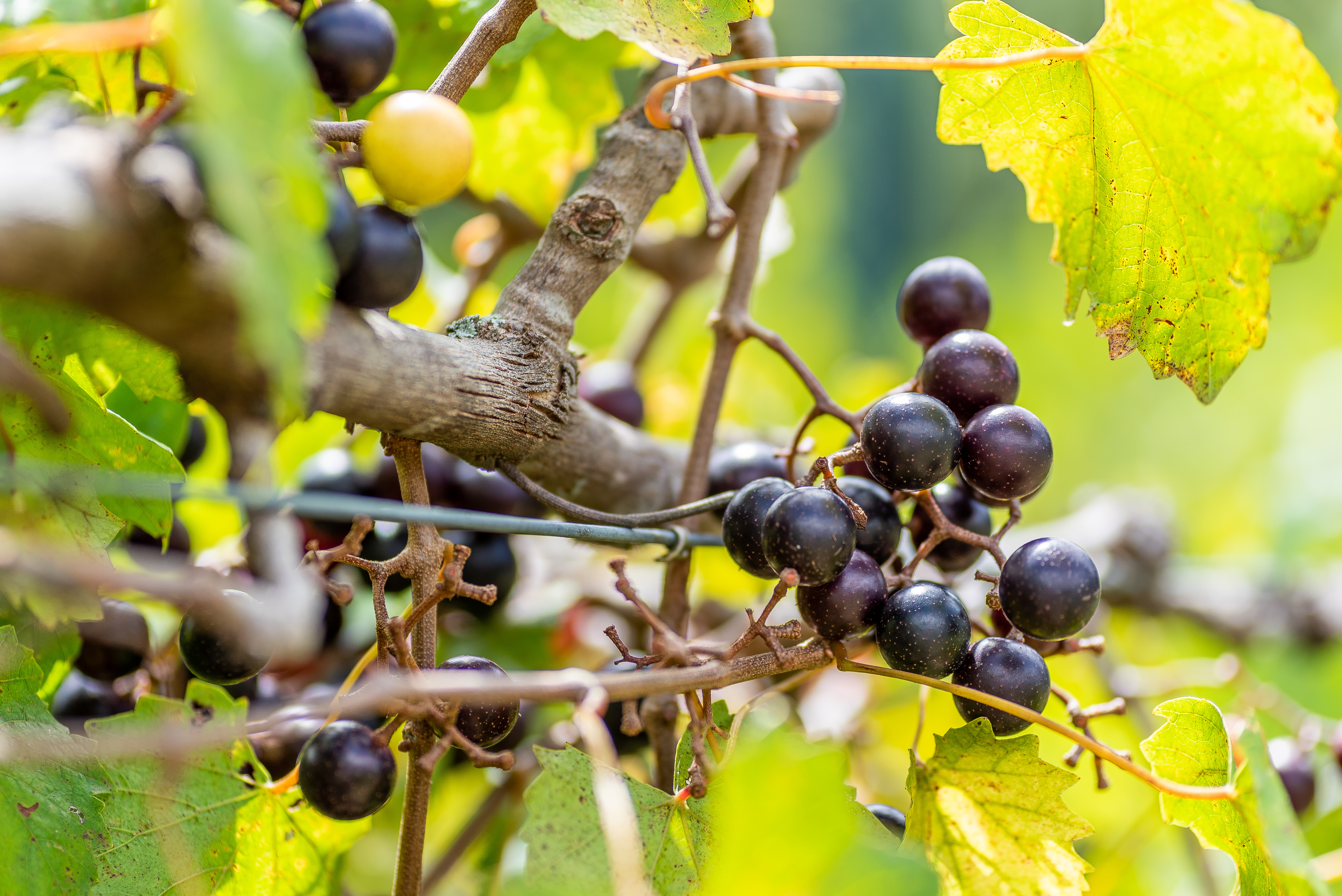
If you are planting a purple muscadine cultivar, ‘Noble’ is an ideal choice due to its productivity, disease resistance, and high-quality juice. Photo by Leonard, Adobe Stock.
Discover the Charm of Muscadines
Imagine walking through endless rows of lush grapevines, each brimming with clusters of plump, juicy muscadines. Scientifically known as Vitis rotundifolia, muscadine grapes are a species native to the southeastern US, with a range extending northward from Florida to Delaware and westward to east Texas and Oklahoma.
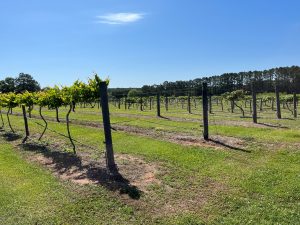
The FAMU Center for Viticulture and Small Fruit Research serves as a hub for studying and developing new cultivation techniques, aiming to enhance muscadine grape quality and resilience to various pests and diseases. Photo by Molly Jameson.
Unlike their traditional grape cousins, muscadines have a unique, robust flavor profile that is often described as rich, sweet, and pleasantly tart. For those who grew up enjoying muscadines, their taste often brings back fond memories of languid, late summer days. Here in the Panhandle, muscadines thrive in our long, hot summers and flourish in our sandy, well-drained soils.
Muscadine grapes are not only a delight for our taste buds, but they are also packed with antioxidants, vitamins, and minerals, making them a powerhouse of nutrition. The high levels of the polyphenol resveratrol, a potent antioxidant, have been linked to numerous health benefits.
In the culinary world, muscadine grapes, with their thick skins and rich colors, spark creativity and exploration. Their unique flavor makes them perfect for everything from fresh fruit to preserves, pies, tarts, and juice. And naturally, muscadine grapes are ideal for winemaking, bringing a distinct twist to the wine market.
While muscadine grapes may not possess the storied history of their European counterparts, they have a rich history of their own in the southeastern US, where they are native and have been a significant part of the region’s agricultural and cultural landscape for centuries. Native American tribes in the southeast, including the Cherokee and Seminole, were the first humans to utilize muscadine grapes. They used the grapes for food and medicinal purposes, appreciating their nutritional value and distinct flavor. In the 1500s, early European settlers, including the English explorer Sir Walter Raleigh, documented the abundance of muscadines growing wild. Seeing their potential, settlers began cultivating muscadine grapes for winemaking and other purposes.
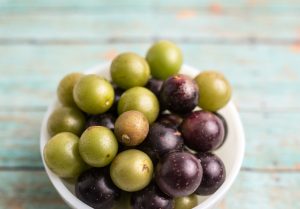
Muscadine grapes come in a variety of colors, including deep purple, black, bronze, and green, each offering its unique flavor profile and appeal. Photo by Tanya, Adobe Stock.
Unlike European grapes, muscadines are naturally more resistant to many common grape diseases, such as anthracnose and Pierce’s disease, and are less susceptible to pests due to their thick skins and natural antifungal compounds. However, they can still be affected by diseases such as angular leaf spot and other fungal rots, and pests such as grape vine borer, birds, raccoons, and deer. In contrast, European grapes are highly susceptible to a range of fungal and bacterial diseases, including powdery mildew and botrytis bunch rot, and are more vulnerable to pests, such as grape berry moths. European grapes also require specific chilling hours which cannot be achieved in the southeast US, and they are more sensitive to both drought and excessive moisture, requiring careful irrigation management and more intensive fertilization.
Today, muscadine grapes are cultivated extensively in the southeast, catering to niche markets. In Florida, there are many muscadine cultivars that thrive, each known for its unique characteristics and adaptability. Cultivars such as the purple ‘Alachua’ and ‘Noble’ and the bronze ‘Carlos’ are popular choices among growers for their high yields and suitability for winemaking, producing wines noted for their fruity flavors and distinct aroma. Muscadines like the purple ‘Supreme’ and the bronze ‘Fry’ and ‘Summit’ are renowned for their sweet taste and are often enjoyed fresh or used in jams and desserts. The muscadine harvest season typically starts in early August and goes through early October, depending on the cultivar, so it pays to grow a variety to extend the season. For more information about muscadine grape cultivars, check out the UF/IFAS Extension EDIS publication The Muscadine Grape.
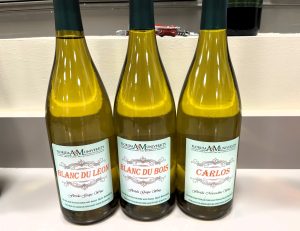
The wine produced at the FAMU Center for Viticulture and Small Fruit Research in Tallahassee showcases the region’s rich muscadine flavors with a focus on innovation and quality. Photo by Molly Jameson.
With ongoing research and cultivation efforts, Florida is broadening its range of muscadine cultivars, ensuring a diverse and thriving grape industry. This research is actively enhancing muscadine varieties, including at the Florida A&M University (FAMU) Center for Viticulture and Small Fruit Research located in Tallahassee.
Efforts at the Center focus on improving grape and small fruit cultivars, particularly those adapted to Florida’s unique climate. Their research includes enhancing disease resistance, boosting fruit quality, increasing yields, releasing new cultivars, and emphasizing sustainable agricultural practices.
Be sure to visit the FAMU Center for Viticulture and Small Fruit Research during the annual Grape Harvest Festival. This year, the festival will be held Saturday, September 14, 2024, from 8 a.m. to 3 p.m., featuring activities such as a vineyard run and walk-a-thon, insect demonstrations and computer simulations, grape varietals tasting, guided vineyard trailer rides, grape throwing and stomping competitions, a wine making workshop, grape picking, and more. Learn more and register to attend the festival at https://my.famu.edu/event/ghf24.















